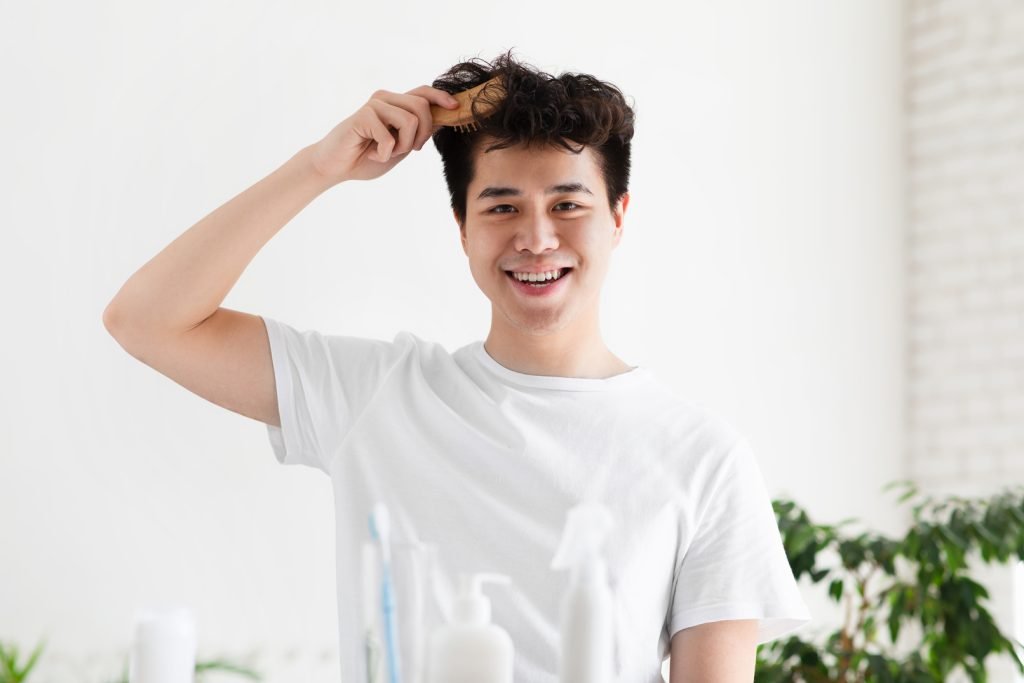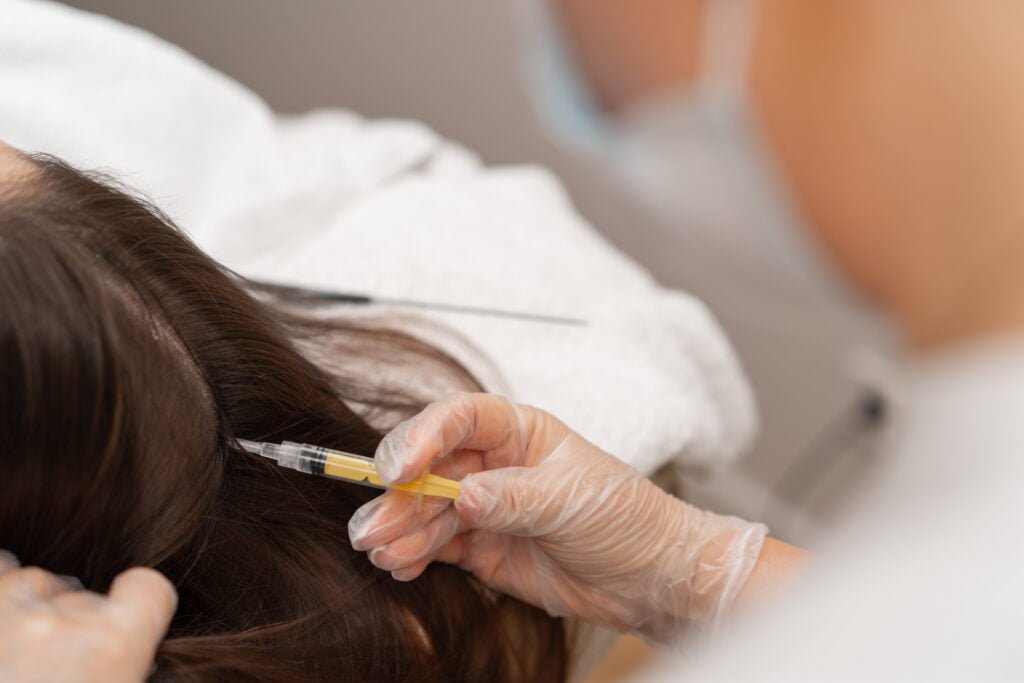
Hair can make you or break you. If you’re seeking effective solutions for male baldness, understanding the top treatments is vital. From topical minoxidil to hair transplant surgery, each option offers a unique approach to combating hair loss and restoring your hair.
Many young men with the genetic predisposition of balding before getting to their 30s are deep diving into the many modern solutions aesthetic clinics can offer. A Klinik is no stranger to these types of treatments, so let’s explore your options one by one.
What is Male Pattern Baldness?
Male pattern baldness typically affects a significant percentage of men, presenting as a gradual onset of hair thinning and specific balding patterns on the scalp. By age 50, around 50% of men will experience noticeable hair loss and it is more likely for you to experience male pattern baldness if members of your family also have it.
This condition, also known as androgenic alopecia, is influenced by genetic factors and the hormone dihydrotestosterone (DHT). Testosterone, a male sex hormone, converts to DHT in the scalp. DHT shrinks hair follicles over time, leading to thinner, shorter hair growth and eventually, baldness. Men with higher sensitivity to DHT are more prone to male pattern baldness.
Signs and Symptoms of Hair Loss
The primary sign of male pattern baldness is a gradual thinning of hair, often starting at the temples and crown of the head. Here are some common indicators:
- Receding hairline
- Widening part line
- Increased hair shedding
- Noticeably thinner hair
- Visible scalp
Stages of Male Pattern Baldness

The Hamilton-Norwood scale categorises male pattern baldness into seven stages based on the extent of hair loss, ranging from a receding hairline to more widespread balding. This pattern of male pattern baldness progresses gradually over time.
Stage 1: Minimal hair loss, with a slight recession of the hairline at the temples.
Stage 2: Further receding hairline, forming an “M” shape.
Stage 3: Hair loss progresses on the crown of the head, creating a circular bald spot.
Stage 4: The receding hairline and bald spot on the crown enlarge, potentially merging into a larger bald area.
Stage 5: Significant hair loss on the top and front of the scalp, with a horseshoe-shaped pattern of remaining hair on the sides and back.
Stage 6: Only a thin fringe of hair remains around the sides and back of the scalp.
Stage 7: Extensive baldness, with only a small patch of hair remaining on the scalp.
It’s important to note that this is a general progression, and individual experiences may vary, depending on where the balding starts on the scalp.
While male pattern baldness isn’t a health risk, it can have huge effects on someone’s self-esteem and their mental well-being. Understanding the genetic and hormonal causes of this condition can help narrow down the best option moving forward.
1. Medications for Male Baldness
Commonly used medications for treating baldness in men include minoxidil and finasteride. These medications have shown effectiveness in promoting hair growth and preventing further hair loss in individuals experiencing male pattern baldness.
Finasteride
Finasteride is an oral medication primarily used to treat male pattern baldness (androgenetic alopecia). It functions by inhibiting the enzyme responsible for converting testosterone into dihydrotestosterone (DHT). By reducing DHT levels, finasteride helps to slow hair loss and, in many cases, promote hair regrowth.
Clinical studies have shown that finasteride can effectively slow the progression of hair loss and increase hair density. It is most effective in the crown area and can help prevent further hair loss when started early. Many users experience visible improvements within 3 to 6 months of treatment, with continued use showing sustained results.
Finasteride is typically taken as a daily oral tablet. It is important for patients to follow the prescribed dosage and consult their healthcare provider regularly to monitor progress and manage any potential side effects.
Minoxidil
Minoxidil is a topical solution applied directly to the scalp. It works by stimulating hair follicles and increasing blood flow to the area, which can help rejuvenate dormant follicles and encourage new hair growth. Minoxidil’s mechanism of action is not fully understood, but it is believed to prolong the anagen (growth) phase of the hair cycle and improve follicle health.
Minoxidil is effective in treating hair loss in the crown area and is often used in conjunction with other treatments. Results can vary, with some users seeing improvement in as little as 2 to 3 months. The effectiveness of minoxidil is more noticeable in individuals with early to moderate hair loss.
It’s typically applied to the scalp twice daily. It comes in various formulations, including liquid and foam, and should be used consistently for the best results. It is essential to apply it directly to the scalp and avoid washing the area for at least 4 hours to ensure absorption.
| Aspect | Finasteride | Minoxidil |
|---|---|---|
| Type | Oral medication | Topical solution |
| How It Works | Inhibits 5-alpha reductase enzyme, reducing DHT levels | Stimulates hair follicles and increases blood flow |
| Primary Use | Treats male pattern baldness by reducing hormonal effects | Treats hair loss by directly stimulating follicles |
| Duration for Results | Results typically seen in 3 to 6 months of use | Results can be seen in 2 to 3 months of use |
| Side Effects | Decreased libido, erectile dysfunction, reduced ejaculate volume | Scalp irritation, itching, dryness |
Combining Finasteride and Minoxidil
Using finasteride and minoxidil together can have synergistic effects to treating male pattern baldness. While finasteride addresses hair loss by reducing DHT levels, minoxidil works to stimulate and nourish hair follicles. This combination targets hair loss from multiple angles, potentially leading to more significant improvements in hair density and growth compared to using either treatment alone.
When considering medications for male baldness, consulting with a doctor is necessary to determine the most suitable treatment plan for your specific needs. Starting with minoxidil or finasteride and adjusting the treatment regimen based on individual response may lead to best results in managing male pattern baldness.
2. Low-Level Laser Therapy
Low-Level Laser Therapy (LLLT), also known as low-level laser light therapy or cold laser therapy, is a non-invasive treatment used to promote hair growth and improve hair health. It uses low-intensity lasers or light-emitting diodes (LEDs) to stimulate hair follicles and enhance the overall environment of the scalp.
LLLT works by delivering specific wavelengths of light to the scalp, which penetrate the skin and reach the hair follicles. This light energy is absorbed by the cells, leading to various biological effects:
- Stimulates Hair Follicles: The light energy enhances cellular metabolism and increases the activity of hair follicle cells, promoting their growth and improving the quality of the hair.
- Increases Blood Circulation: LLLT boosts blood flow to the scalp, ensuring that hair follicles receive more oxygen and nutrients necessary for healthy hair growth.
- Reduces Inflammation: The therapy helps to decrease inflammation in the scalp, which can improve follicle health and reduce conditions that may hinder hair growth.
For optimal results, LLLT typically requires regular sessions. Most protocols involve using the device 2-3 times per week, with each session lasting about 20-30 minutes. For optimal results, LLLT typically requires regular sessions. Most protocols involve using the device 2-3 times per week, with each session lasting about 20-30 minutes. Low-level laser therapy offers a safe and effective option for individuals seeking to address male pattern baldness.
3. Hair Transplants

Follicular Unit Transplantation (FUT) and Follicular Unit Extraction (FUE) are two widely recognized surgical techniques for hair restoration. Both methods involve transplanting healthy hair follicles to balding areas, but they differ in their procedure and outcomes.
FUT, also known as strip harvesting, involves removing a strip of skin from the donor area, typically the back of the scalp, where hair is genetically resistant to balding. The strip is then dissected into individual follicular units, which are small groups of hair follicles. These units are transplanted into tiny incisions made in the balding areas.
FUE involves extracting individual follicular units directly from the donor area using a specialised punch tool. These units are then transplanted into the recipient area. Unlike FUT, FUE does not require removing a strip of skin.
Hair transplant surgeries can provide natural-looking results that blend seamlessly with existing hair. These procedures have a high success rate, with minimal scarring and downtime, making them a popular choice for individuals seeking long-lasting results.
4. Hair Fillers

Hair fillers, a non-surgical treatment for male baldness, involve injecting substances like hyaluronic acid into the scalp to enhance volume and density in thinning areas. These fillers provide immediate results by plumping up the hair follicles, creating the appearance of thicker hair.
While they are temporary solutions lasting several months before touch-up injections are needed, the procedure is quick, minimally invasive, and well-tolerated with minimal downtime. It’s important to note that while hair fillers can improve the look of thinning hair, they do not address the underlying causes of male pattern baldness.
5. Platelet Rich Plasma Injections
PRP therapy involves injecting platelets from the patient’s blood into the scalp to stimulate hair growth. They growth factors that may help rejuvenate hair follicles and promote thicker, healthier hair. This treatment is minimally invasive and is often used alongside other hair loss treatments for enhanced results.
PRP therapy has shown promising results in improving hair density and thickness in individuals with male pattern baldness. Multiple sessions may be recommended to achieve ideal outcomes for male baldness treatment.
Choosing Combination of Treatments for Hair Loss
Combining treatments, such as oral medications like minoxidil or dutasteride with procedures like PRP therapy or hair transplants, can target hair loss from multiple angles. Research indicates that a combination of treatments may yield superior results compared to using a single treatment method alone.
Consulting with a doctor is vital to determine the most suitable combination of treatments based on individual needs and response. This personalised approach can optimise treatment outcomes and enhance the overall management of male pattern baldness.
Hair Restoration Clinic in Penang
Find Hair Loss Solutions at A Klinik Signature

Combining treatments for male baldness can significantly enhance results by addressing the condition from multiple angles. Whether through medications, hair transplantation, PRP therapy, or other methods, a comprehensive approach allows for a more effective strategy in managing hair loss. Consult with one of our doctors today for a personalised treatment plan to restore your hair!








